Last updated on
Discover the art of harmoniously pairing kitchen cabinets and countertops, transforming your cooking space into a visually stunning and functional haven.
The kitchen is the heart of any home, and it’s essential to create a space that is not only functional but also aesthetically pleasing. One of the most crucial aspects of designing a kitchen is choosing the right cabinets and countertops.
They are the backbone of your kitchen design, and if they don’t match well, it can throw off the entire look. In this article, we’ll be discussing some tips on how to match kitchen cabinets and countertops seamlessly.
Whether you’re renovating your existing kitchen or building a new one from scratch, these tips will help you create a cohesive and beautiful space that you’ll love spending time in. So let’s get started!
What's Inside
Assessing Your Kitchen Space

Before you start selecting cabinets and countertops, it’s essential to assess your kitchen space. Take a good look at the size of your kitchen, its layout, and the amount of natural light that comes in.
These factors will play a significant role in determining what kind of cabinets and countertops will work best for you.
If you have a small kitchen with limited counter space, consider installing lighter-colored cabinets to create an illusion of more room. On the other hand, if you have ample counter space but not enough storage area for all your appliances or cookware items – then opt for taller cabinetry with plenty of shelves.
The layout is another crucial factor when assessing your kitchen space as it can affect how well different cabinet styles fit into place. For example: If there are corners or awkward angles in your cooking area – then choosing corner units might be necessary to maximize storage capacity while maintaining functionality.
The Importance of Kitchen Layout
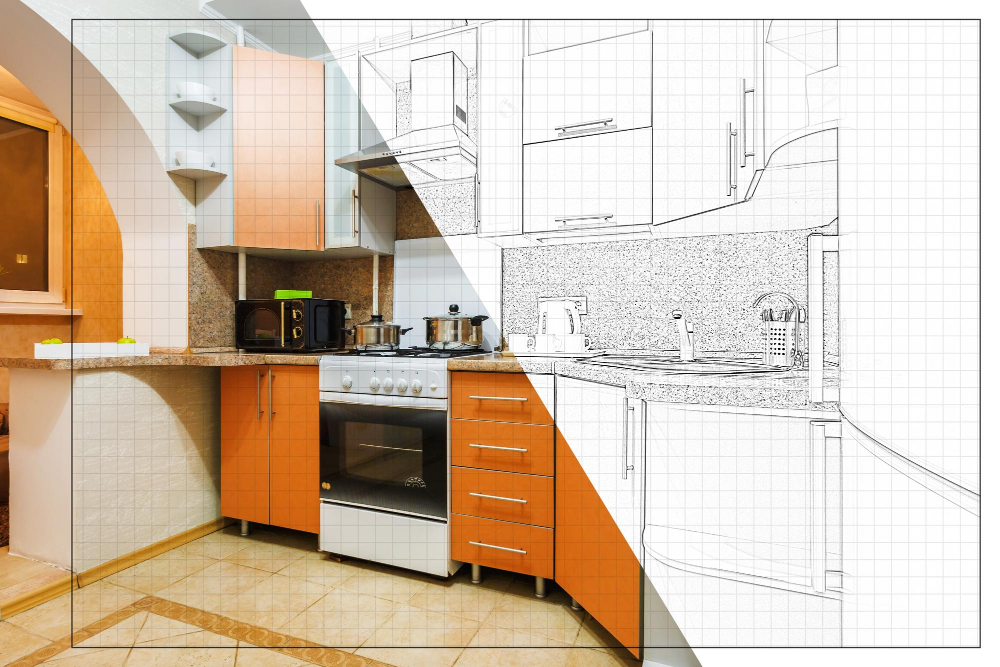
A well-designed kitchen layout can make all the difference in how functional and efficient your space is, as well as how visually appealing it looks. Before you start selecting materials for your cabinets and countertops, take some time to assess your current kitchen’s layout or plan out a new one if you’re starting from scratch.
Consider things like traffic flow, work zones (preparation, cooking, cleaning), appliance placement, storage needs (both food and dishware), seating areas if applicable – all these elements will impact where you place cabinetry or install counters.
For example: If you have a small galley-style kitchen with limited counter space but ample wall cabinet storage options; then choosing lighter colored countertop material that reflects light can help create an illusion of more open space while darker wood finishes on upper cabinetry add warmth without making the room feel cramped.
Choosing Cabinet Materials
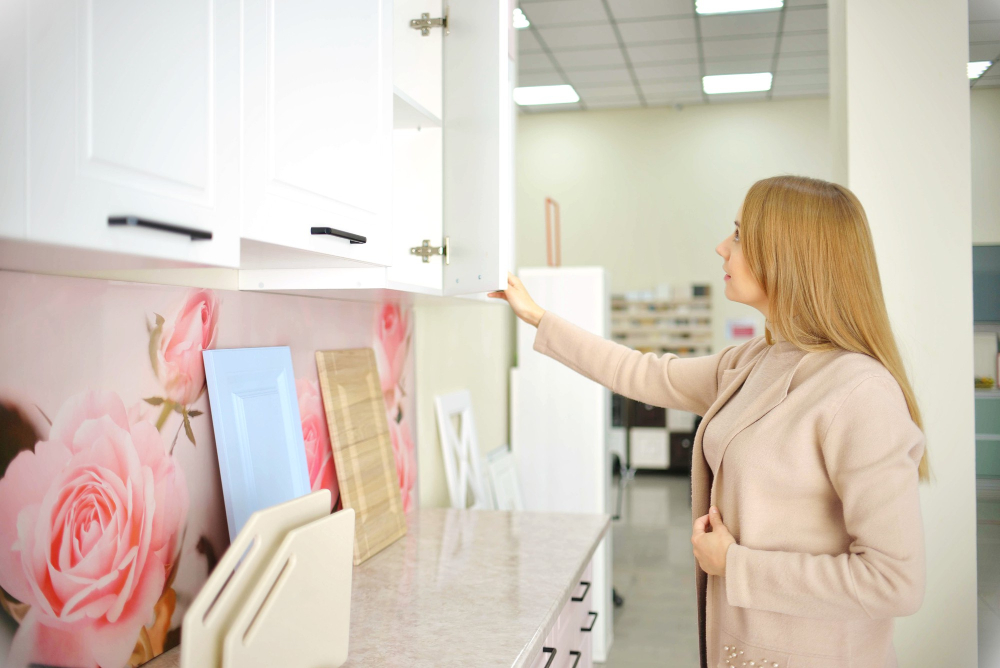
The most popular ones include wood, laminate, metal and glass. Wood is a classic choice that adds warmth and character to any kitchen design.
It’s also durable and can be stained or painted in various colors.
Laminate cabinets are an affordable option that offers a wide range of color choices and finishes. They’re easy to clean but may not last as long as other materials.
Metal cabinets give your kitchen an industrial look while being sturdy enough for heavy use. Glass-fronted cabinets add elegance by showcasing your dishware collection or decorative items.
It’s essential to consider factors such as durability, maintenance requirements, cost-effectiveness when selecting cabinet material for your kitchen renovation project. Ultimately the decision should be based on personal preference combined with practical considerations like budget constraints or lifestyle needs.
Selecting Countertop Materials

Each material has its unique characteristics and advantages that make them suitable for different kitchen designs and lifestyles. Some popular choices include granite, marble, quartz, concrete, butcher block wood countertops or even stainless steel.
Granite is a natural stone that offers durability and resistance to heat and scratches. It’s available in various colors with unique patterns making each slab one-of-a-kind.
Marble is another natural stone option known for its elegance but requires more maintenance than other materials due to its porous nature.
Quartz countertops offer the look of natural stones like granite or marble but are engineered with added benefits such as being non-porous which makes them resistant to stains while also providing durability against chips or cracks.
Concrete counters provide an industrial feel while offering customization options such as color pigments mixed into the concrete mix before pouring it into molds creating endless design possibilities.
Butcher block wood countertops add warmth & texture; they require regular oiling & sealing but can be sanded down if scratched over time.
Stainless steel provides a sleek modern look perfect for contemporary kitchens; however fingerprints show up easily on this surface requiring frequent cleaning.
Ultimately your choice will depend on your budget constraints along with personal preferences regarding aesthetics versus functionality.
Coordinating Color Schemes
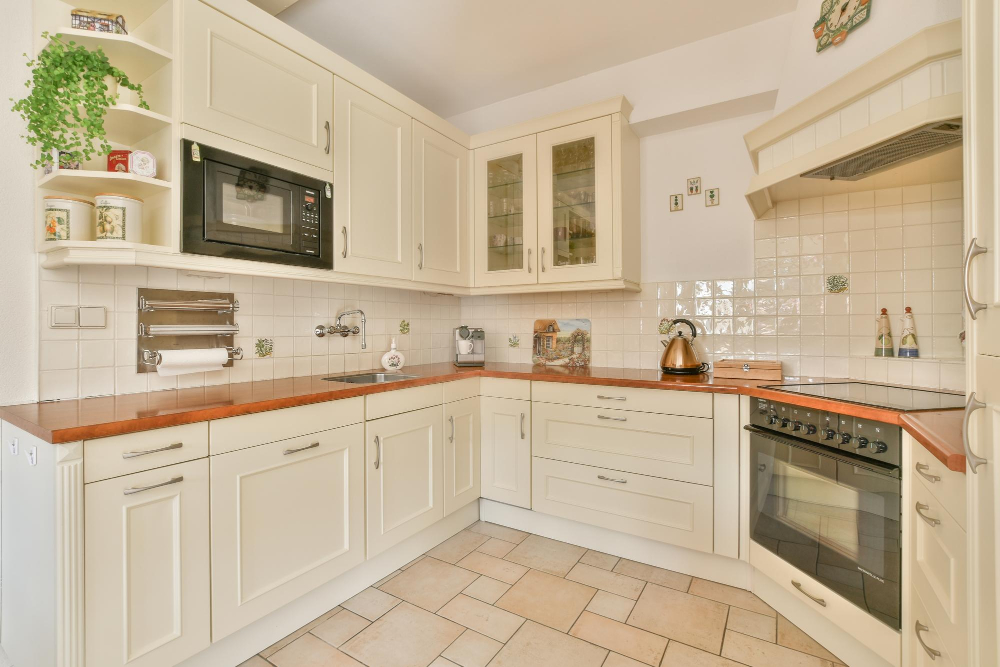
The right color scheme can make your kitchen look cohesive and visually appealing. One way to coordinate colors is by choosing a monochromatic palette, which involves selecting different shades of the same hue for your cabinets, countertops, backsplash tiles or walls.
Another option is to use complementary colors that are opposite each other on the color wheel. For example, if you have white cabinets with black hardware accents in your kitchen design plan; then pairing them with a dark countertop like granite or soapstone will create an eye-catching contrast.
If you prefer more subtle contrasts in your design choices; consider using analogous colors that sit next to each other on the wheel such as blue-green-gray combinations for a calming effect.
Matching Cabinet and Countertop Styles
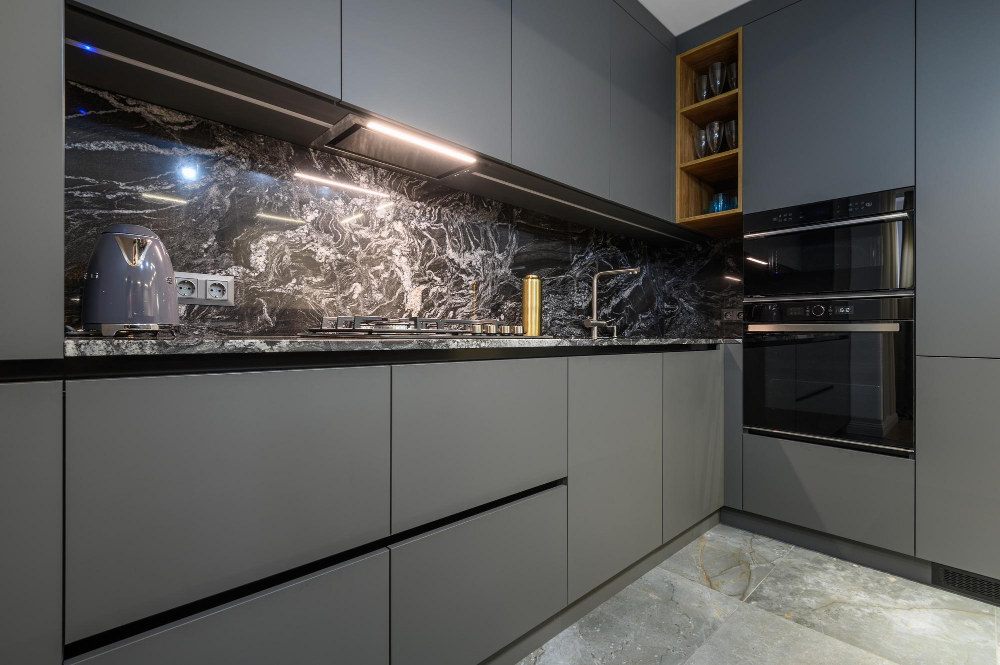
First, you’ll want to think about the overall style of your kitchen. Is it modern or traditional? Sleek or rustic? Once you have an idea of the style you’re going for, choose cabinets and countertops that complement each other.
For example, if you’re going for a modern look in your kitchen with clean lines and minimalistic design elements, then flat-panel cabinets with simple hardware would be an excellent choice. Pair them with quartz countertops that have a smooth finish for a cohesive look.
On the other hand, if your kitchen has more traditional elements like ornate moldings or decorative accents on cabinetry doors and drawers; then opt for granite countertops in warm tones such as beige or brown hues paired with raised panel wood cabinetry finished in rich stains like cherrywood.
Matching cabinet and countertop styles is all about creating balance between different design elements while keeping functionality at its core.
Creating Texture in Your Kitchen Design
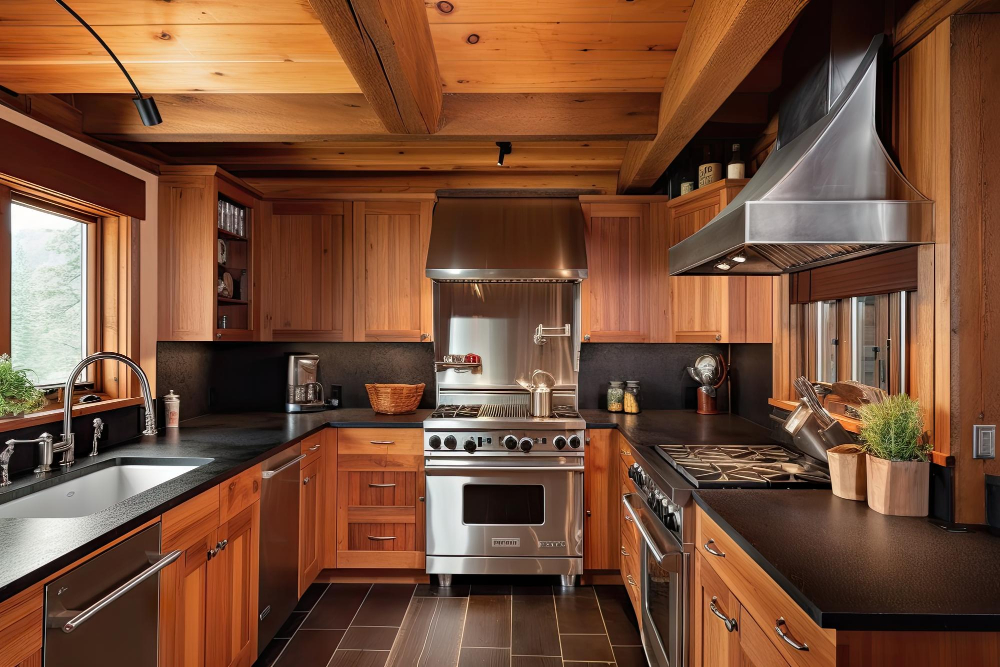
When choosing cabinets and countertops, consider incorporating different textures to create a cohesive look that’s both visually appealing and functional.
For example, you might choose cabinets with a smooth finish paired with rough-hewn stone or wood countertops. Or you could opt for textured glass cabinet doors paired with sleek quartz or granite counters.
Another way to incorporate texture into your kitchen design is through the use of backsplash tiles. You can choose from a variety of materials such as ceramic, glass, metal or natural stone tiles that come in various shapes like hexagonal mosaics or subway-style rectangles.
By adding texture into your kitchen design elements like cabinetry finishes (matte vs glossy), countertop surfaces (polished vs honed) flooring options (wooden planks vs patterned tile), lighting fixtures etc., you’ll be able to create visual interest while also making sure everything works together harmoniously.
Creating texture in your kitchen design adds depth and dimensionality while creating visual appeal.
Balancing Cabinet and Countertop Finishes
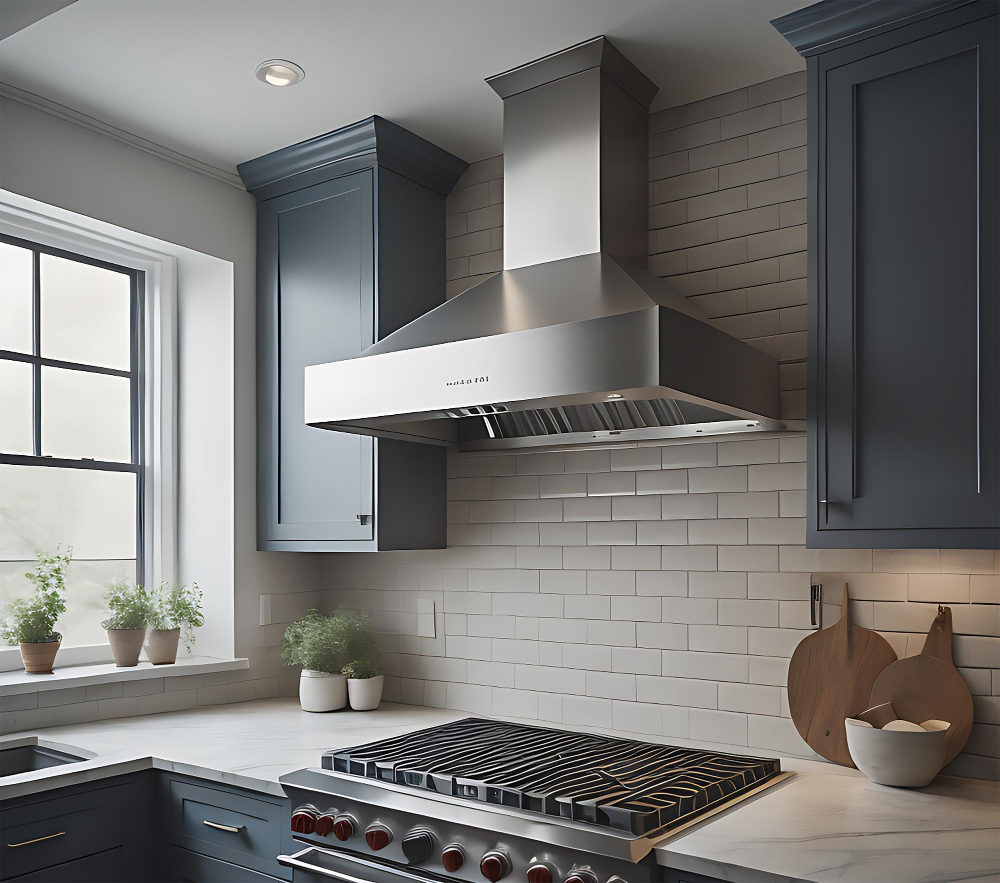
The finish on your cabinets can make a significant impact on how well they pair with your chosen countertop material. For example, if you have dark wood cabinets with a glossy finish, pairing them with shiny granite countertops may create an overwhelming effect.
To balance cabinet and countertop finishes effectively, you need to choose complementary materials that work together harmoniously. If you have light-colored cabinetry in matte or satin finishes, consider pairing them with darker stone or quartz countertops in polished or honed finishes for contrast.
Alternatively, if your cabinetry has a more prominent grain pattern like oak or maple wood grains that are visible through their stain coloration; choosing solid surface counters such as Corian will help balance out these natural textures without competing against each other visually.
Complementary Vs. Contrasting Designs
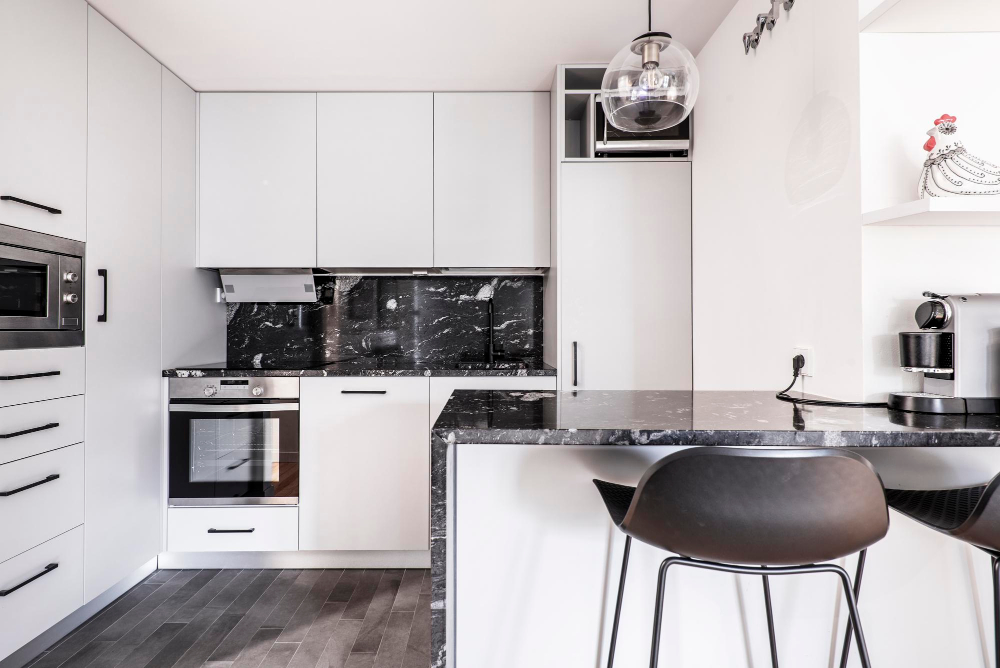
Complementary designs involve selecting colors that are next to each other on the color wheel, creating a harmonious look. Contrasting designs involve choosing colors that are opposite each other on the color wheel, creating a bold and eye-catching look.
Complementary design is ideal for those who prefer a more subtle approach to their kitchen design. This style creates an effortless flow between your cabinets and countertops while still adding visual interest through texture or pattern.
On the other hand, contrasting design can add drama and excitement to your space by using bold hues or unique materials in unexpected ways. However, it’s important not to go overboard with this approach as too much contrast can be overwhelming.
Ultimately whether you choose complementary or contrasting designs will depend on personal preference as well as factors such as lighting conditions in your kitchen space.
Selecting Backsplash to Complement Cabinets and Countertops
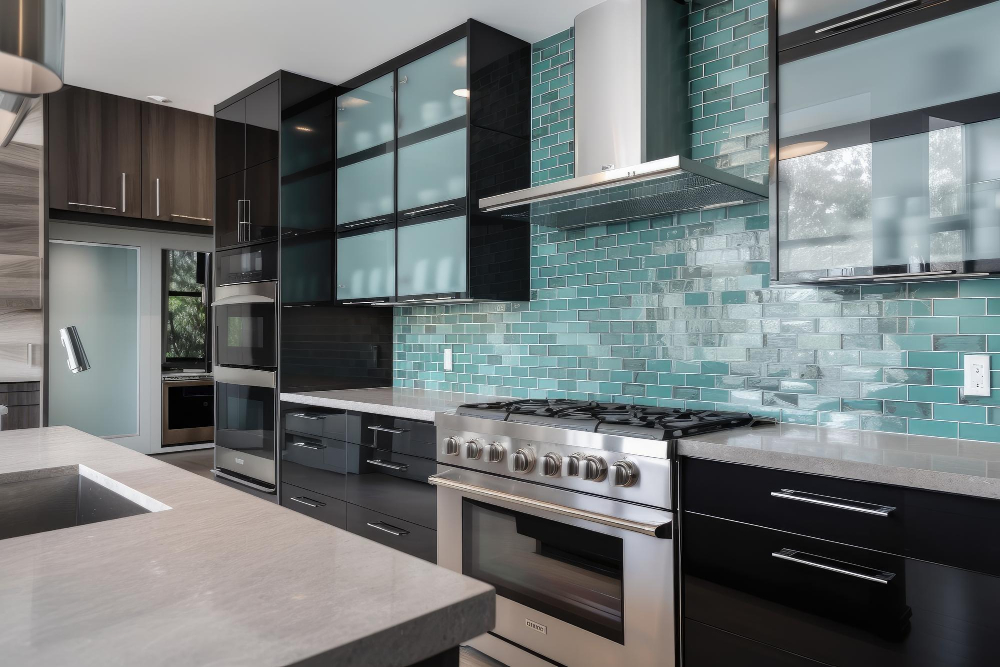
A backsplash can add texture, color, and personality to your kitchen design while also protecting walls from spills and splatters. When selecting a backsplash that complements your cabinets and countertops, consider using materials that tie in with both elements of your design.
For example, if you have chosen white shaker-style cabinetry with black granite countertops for a classic look in your kitchen space; you may want to opt for a subway tile or mosaic glass tile backsplash in shades of gray or black. This will create an elegant yet cohesive look throughout the entire space.
Alternatively, if you’ve gone for natural wood cabinetry paired with quartzite counters; try incorporating earthy tones into the tiles such as beige or brown hues which will complement both elements beautifully.
Remember always to keep balance when coordinating colors between all three components (cabinets/countertops/backsplashes).
Coordinating Kitchen Flooring Options
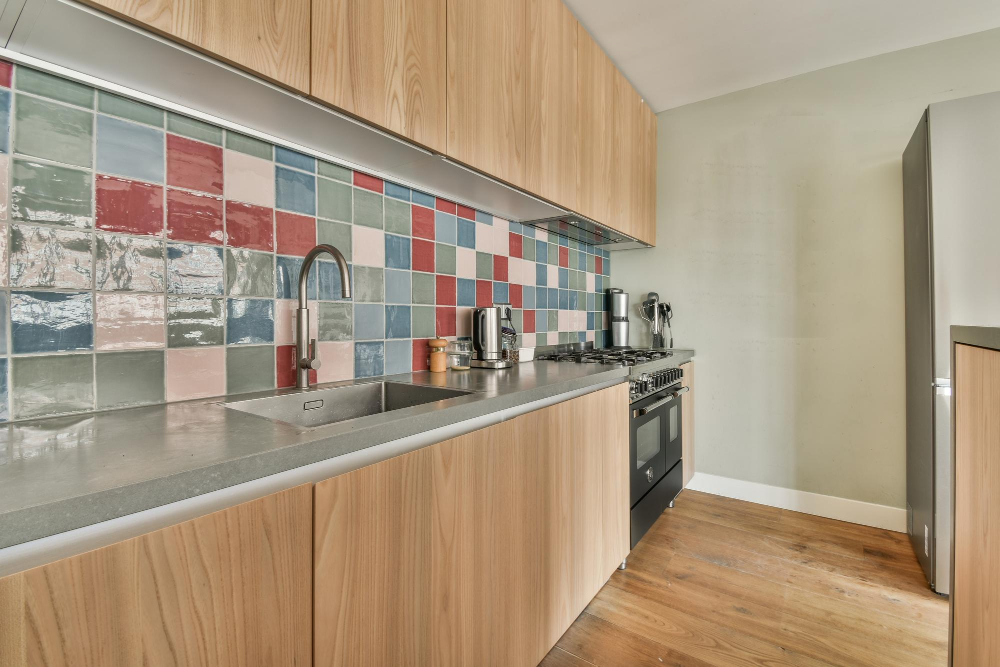
The right flooring can tie everything together and create a cohesive look that elevates your entire design. When choosing kitchen flooring options, consider factors such as durability, maintenance requirements, style preferences, and budget.
One popular option for kitchen floors is hardwood or engineered wood. It adds warmth to space while also being durable enough to withstand heavy foot traffic in high-use areas like kitchens.
If you’re looking for something more low-maintenance than natural wood floors but still want a similar aesthetic appeal then vinyl plank or laminate are great alternatives.
Tile is another excellent choice for kitchens because of its durability and easy-to-clean surface; it’s available in various colors & patterns that can complement any cabinet/countertop combination.
Integrating Kitchen Island Design

It can serve as extra counter space, storage, or even a dining area. When it comes to matching your cabinets and countertops with your kitchen island design, there are several factors to consider.
Firstly, you should decide on the size of the island based on the available space in your kitchen. The size of the island will determine how many cabinets you can incorporate into its design.
Secondly, consider whether you want contrasting or complementary colors for your island’s countertop and cabinet finishes. If you’re going for contrast in color schemes between cabinets/countertops vs an accent piece like an Island then choose something that stands out from everything else but still complements them well.
Timeless Vs. Trendy Choices

Timeless designs are classic and will never go out of style, while trendy designs follow the latest fads and may become outdated quickly. While both options have their pros and cons, choosing a timeless design is often the best choice for those who plan on staying in their home long-term.
Timeless kitchens typically feature neutral colors such as white or beige cabinets paired with natural stone countertops like granite or marble. These materials have been used in kitchens for centuries and will continue to be popular choices due to their durability and versatility.
On the other hand, if you’re looking for something more modern that follows current trends, then opting for bold colors like navy blue cabinets paired with quartz countertops might be more your style. However, keep in mind that these trends can quickly become outdated within just a few years.
Ultimately it’s up to personal preference when deciding between timeless vs.
Popular Cabinet, Countertop, and Floor Combinations

Some pairings have become more popular than others over the years. For example, white cabinets with marble countertops and hardwood floors create a classic look that never goes out of style.
Another popular combination is dark wood cabinets paired with granite countertops and tile flooring for a warm and inviting feel.
If you’re looking for something more modern or contemporary in design, consider pairing light-colored cabinets with quartz or concrete countertops along with sleek porcelain tiles on the floor. Alternatively, if you prefer darker tones in your kitchen design scheme but still want a modern look – black cabinetry combined with stainless steel appliances can be complemented by either white marble or black granite counters.
Cabinet to Trim Coordination

Cabinet trim includes crown molding, baseboards, and other decorative elements that can make a significant impact on the overall look of your kitchen.
To achieve a cohesive design in your kitchen space, consider selecting cabinet trims that match or complement both your cabinets and countertops. For example, if you have white shaker-style cabinets with black granite countertops, opt for black crown molding or baseboards to tie everything together.
Alternatively, you could choose contrasting colors for an eye-catching effect. If you have dark wood cabinetry with light-colored quartz counters in shades of gray or beige tones; try adding white painted trims around doors and windows as well as along the ceiling line.
Remember: The goal is not only to create visual harmony but also balance functionality with aesthetics while keeping within budget constraints.
Maintaining Design Consistency
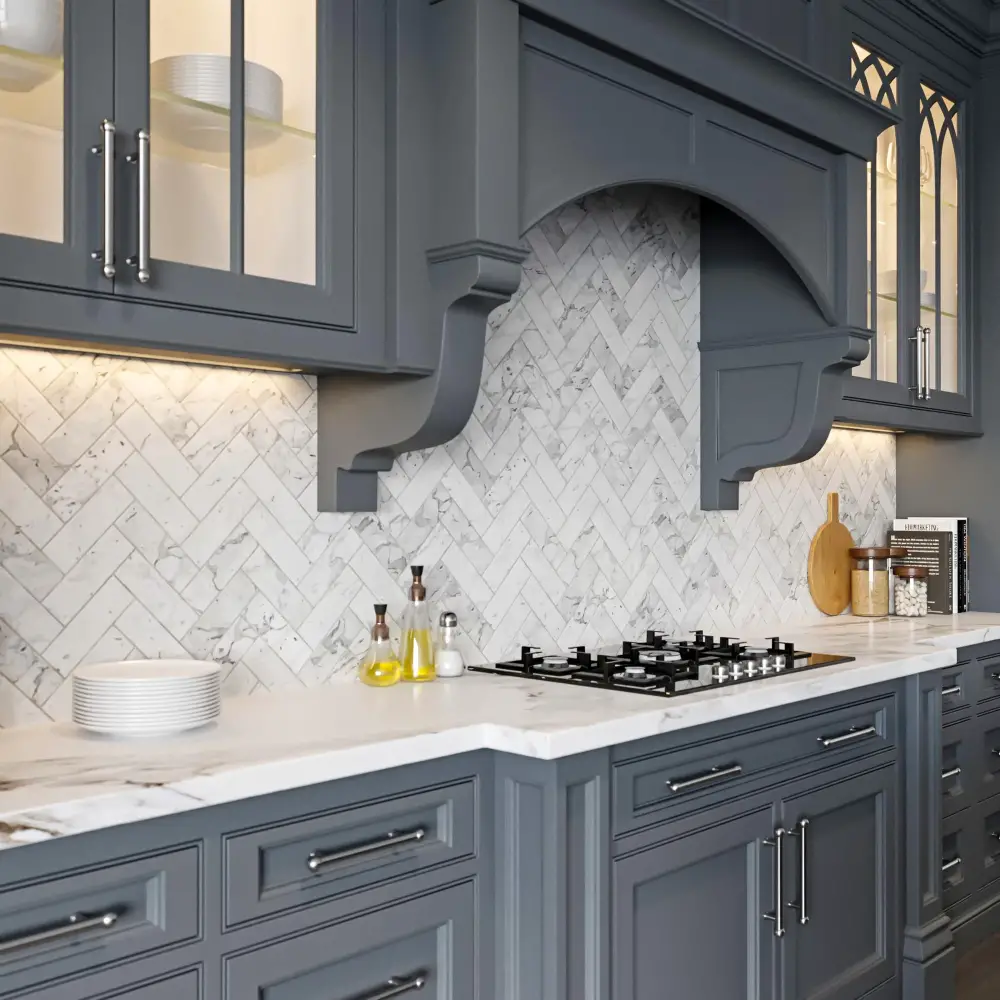
This means ensuring that all of the colors and finishes work together seamlessly. One way to achieve this is by selecting a color scheme for your kitchen and sticking with it.
For example, if you choose white cabinets with a marble countertop, consider incorporating white or gray subway tiles for your backsplash. You can also add pops of color through accessories like dishware or small appliances.
Another way to maintain design consistency is by choosing complementary cabinet hardware that matches the style of your cabinets. For instance, if you have sleek modern cabinetry in brushed nickel finish then opt for matching handles or knobs instead of something ornate in gold finish.
Balancing Functionality and Aesthetics
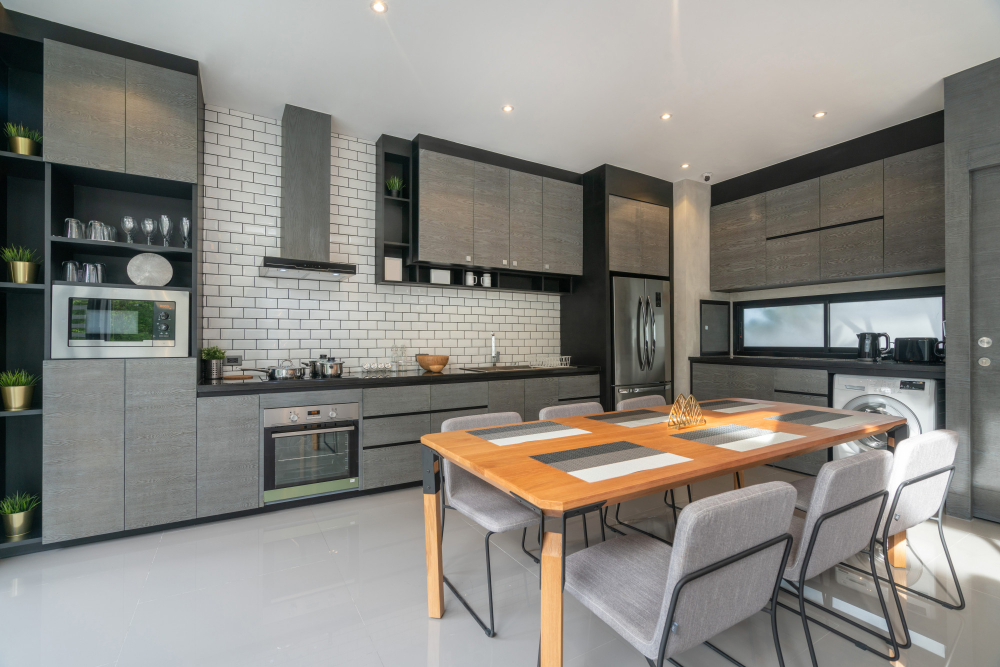
While you want your kitchen to look beautiful, you also need it to be practical and efficient. It’s crucial not only for your daily use but also for resale value if you plan on selling your home in the future.
To achieve this balance, start by assessing how much storage space you need based on how often and what type of cooking or baking activities take place in your kitchen. Consider incorporating pull-out drawers or shelves that make accessing items easier while maximizing storage capacity.
Another way is by selecting appliances that are both functional and visually appealing; stainless steel appliances are popular choices as they offer a sleek modern look while being durable enough for everyday use.
Consider lighting options such as under-cabinet lights which provide task lighting when preparing food while adding ambiance at night-time gatherings with friends or family members.
Considering Your Kitchen’s Lighting
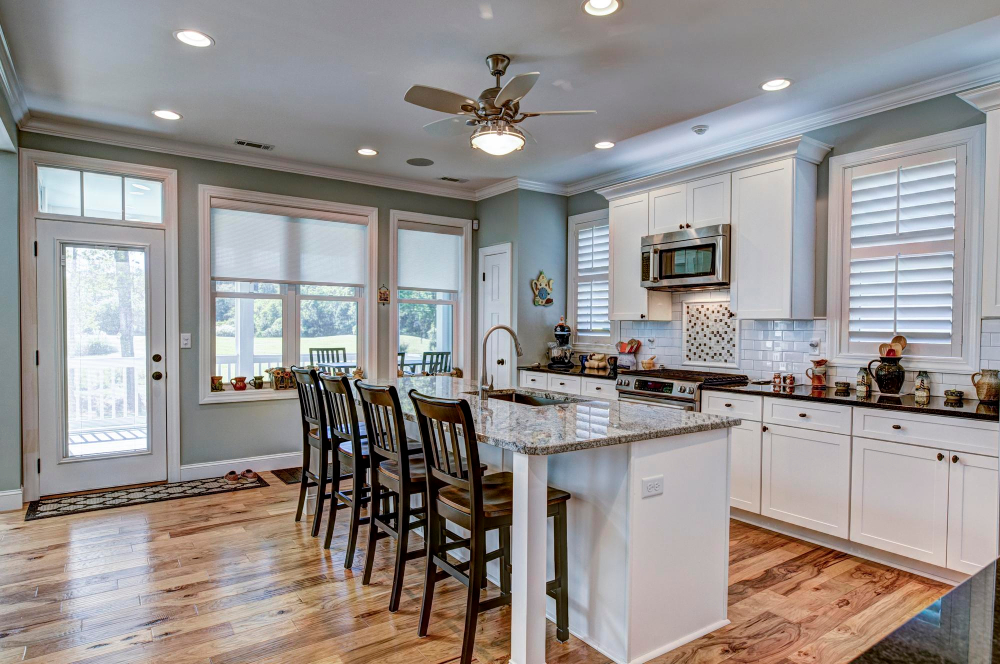
When considering lighting for your kitchen, you need to think about both functionality and aesthetics. The right lighting will not only illuminate your workspace but also enhance the beauty of your cabinets and countertops.
To achieve optimal lighting in your kitchen, start by assessing how much natural light enters the room throughout the day. If you have large windows that let in plenty of sunlight during daylight hours, consider installing dimmer switches on overhead lights to adjust brightness levels as needed.
Next, think about task-specific areas such as above-the-counter workspaces or over-the-stove cooking areas where brighter light may be necessary for safety reasons. Under-cabinet LED strip lights are an excellent option for illuminating these spaces while adding ambiance to darker corners.
Don’t forget about accent lighting! Adding pendant lights above a central island or chandelier-style fixtures over dining tables can create a warm atmosphere while highlighting key features within the room’s design.
Working With Budget Constraints

That doesn’t mean you have to compromise on style or functionality. There are several ways you can work within your budget and still achieve the look and feel you desire.
One of the best ways to save money is by choosing materials that are cost-effective but still durable and stylish. For instance, laminate countertops offer an affordable alternative to pricier options like granite or quartz while providing similar aesthetics.
Another way is by opting for pre-fabricated cabinets instead of custom-made ones as they tend to be less expensive without sacrificing quality. You could also consider painting or refinishing existing cabinets rather than replacing them entirely.
It’s important not only to focus on individual elements but also how they fit together in terms of design cohesiveness when working with a tight budget. Choosing complementary colors and finishes will help create a cohesive look even if some items were purchased at lower price points than others.
Consult a Professional Designer

If you’re struggling with selecting the right materials or coordinating colors, consider consulting a professional designer. They have years of experience in designing kitchens and can help you create a cohesive design that meets all of your needs.
A professional designer will work with you to understand what style and functionality are essential for your kitchen space. They’ll also take into account any budget constraints or other limitations that may impact the design process.
By working with an expert, you’ll save time by avoiding costly mistakes such as choosing materials that don’t complement each other well or creating an unbalanced color scheme. A professional designer will guide you through every step of the process from assessing your space to selecting finishes and accessories.
Matching kitchen cabinets and countertops is not always easy but following these tips should make it easier for anyone looking forward to renovating their cooking area without breaking their bank account while at it!
FAQ
Should countertop be lighter or darker than cabinets?
A countertop should be lighter than cabinets, as experts recommend this for the perfect color blend and ultimate kitchen outlook.
Do countertops have to match cabinets?
Countertops do not necessarily have to match cabinets, as many homeowners experiment with different color combinations and contrasting elements.
What should kitchen countertops match?
Kitchen countertops should match the flooring, creating a balance with the cabinet colors by ensuring a contrast between light and dark elements.
Should kitchen cabinets be darker or lighter than walls?
Kitchen cabinets can be either darker or lighter than walls, as it depends on personal preference and the desired look.
What are the best color combinations for kitchen cabinets and countertops?
Best color combinations for kitchen cabinets and countertops include white cabinets with gray or black countertops, dark cabinets with light countertops, and wood cabinets with neutral or contrasting countertops.
How can you maintain a cohesive design when mixing and matching kitchen cabinets and countertops?
To maintain a cohesive design when mixing and matching kitchen cabinets and countertops, one should ensure that the materials, colors, and styles complement each other and create a balanced visual appeal.
What materials work best together for kitchen cabinets and countertops aesthetics?
For kitchen cabinets and countertops aesthetics, materials like wood and natural stones, such as granite or quartz, work best together.




